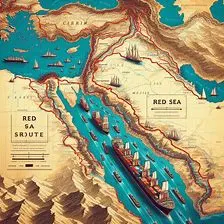Search This Blog
Upcoming Events,Blog articles, Music,Games, Entertainment and lots more..
Featured
- Get link
- X
- Other Apps
The Red sea shipping route
The Red sea shipping route
The Red Sea route is one of the world's most important shipping lanes. It connects Asia, Africa, and Europe, and carries a significant portion of global trade.
The route's significance stems from its location as a shortcut between the Indian Ocean and the Mediterranean Sea.
The Suez Canal, located at the northern tip of the Red Sea, is the key component of the route.
This man-made waterway allows ships to avoid sailing around Africa, saving both time and money. However, the Red Sea itself is also an important shipping lane, even for vessels that aren't using the Suez Canal.
The southern entrance to the Red Sea, the Bab el-Mandeb strait, is another strategic chokepoint.
The Red Sea is vital for the following reasons:
Shorter travel times: The Red Sea route cuts days or even weeks off travel times between Asia and Europe compared to sailing around Africa. This is especially important for time-sensitive goods.
Reduced costs: Shorter travel times translate to lower fuel costs for shipping companies.
Increased capacity: Because ships can make more trips per year using the Red Sea route, it effectively increases global shipping capacity.
The Red Sea is also an important route for oil tankers transporting oil from the Middle East to Europe and Asia. In fact, about 10% of the world's seaborne oil travels through the Red Sea.
The Red Sea route is not without its challenges.
Security concerns in the region, such as piracy and political instability, can sometimes disrupt shipping. Additionally, the Suez Canal is a single point of failure, meaning that a closure of the canal can cause major disruptions to global trade.
Despite these challenges, the Red Sea route remains one of the world's most important shipping lanes.
- Get link
- X
- Other Apps
Popular Posts

Where to buy Taylor Swift Eras tour tickets
- Get link
- X
- Other Apps

Comments